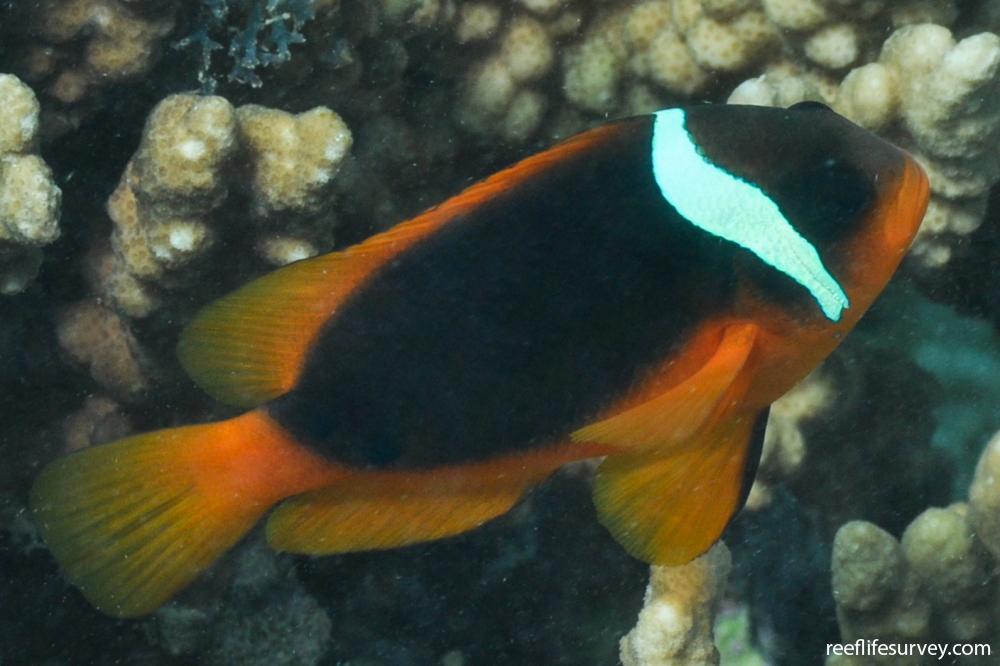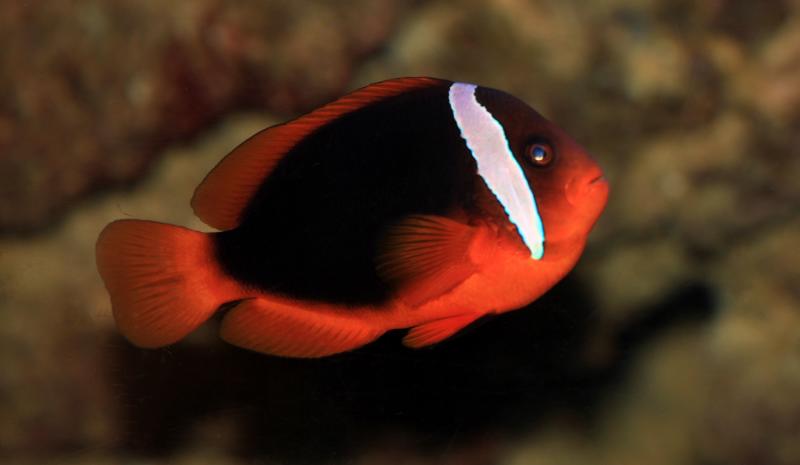The red-striped clown (Amphiprion frenatus), also known as tomato the clown or tomato anemone goby, is one of the most prominent representatives of clownfish. rich red-orange color with a distinctive white stripe behind the eyes it gives it a special recognition among marine fish.
✔ One of the largest representatives of the genus Amphiprion
✔ Bright color that changes with age
✔ Symbiosis with anemones is the basis of its survival
✔ It is popular among marine aquarists due to its unpretentiousness
This view stands out territorial and aggressive behaviorespecially in protecting your anemone.

Scientific classification
✔ The Kingdom: Animals (Animalia)
✔ Type: Chordal (Chordata)
✔ Class: Lucheperi pisces (Actinopterygii)
✔ Row: Perch-like (Perciformes)
✔ Family: Pomacentrovye (Pomacentridae)
✔ Gender: Amphiprions (Amphiprion)
✔ View: Amphiprion frenatus
✔ Described: Benned in 1836
Title frenatus it comes from the Latin "frenatus", meaning" bridle-headed", which probably refers to the white stripe on the head.
Habitat and habitat
🌏 Distribution:
🔹 Western Pacific
Воды Waters around Japan, Taiwan, the Philippines, Indonesia and the Great Barrier Reef
🏝 Living environment:
🔹 Tropical coral reefs at depths of 1-12 meters
💥 Prefers warm lagoons with a water temperature of 25-30°C
, Lives in symbiosis with anemones, separately Entacmaea quadricolor (bubble anemone)
The red-striped clown is usually found in single pairs or small groups.
Appearance and coloring
🔸 Main color:
✔ In young individuals-bright orange
✔ For adults-rich red
🔸 Characteristic band:
✔ One wide white stripe behind the eyes
✔ This band may fade with age
🔸 Size:
✔ Maximum length-14 cm
✔ Females are larger than males
This fish has thick body and strong finswhich makes it hardy in the wild and aquariums.
Lifestyle and behavior
✅ Symbiosis with anemones:
✔ Protects the anemone from other fish
✔ Cleanses the anemone from food residues
✔ Gets protection due to immunity to stinging anemone cells
✅ Social structure:
✔ Lives in hierarchical groupswhere the dominant female controls the territory
✔ If the female dies, the largest male changes sex and takes its place
✅ Aggressiveness:
✔ One of the the most territorial clownfish
✔ Can be aggressive even to other anemone Fish
Food
🔹 The diet consists of:
✔ Zooplankton (small crustaceans)
✔ Algae and sea sponges
✔ Organic residues near the anemone
This view omnivorouswhich makes it easily adaptable to different environments.
Reproduction
🔹 Proteroginal hermaphrodite:
✔ Males can transform into females if necessary
🔹 The breeding process:
✔ Female lays eggs 100-1000 eggs near the anemone
✔ The male guards the clutch and cleans it
✔ Larvae hatch via 6-10 days and drift in the water before settling on the reef
Like all clownfish, A. frenatus passes the stage planktonic larvae, which helps the species spread.

Predators and threats
🔸 Natural enemies:
✔ Large predatory fish (groupers, barracudas)
✔ Predatory anemones
🔸 Threats to the public:
✔ Catch for the aquarium trade
✔ Destruction of coral reefs
✔ Climate change
This view has a relatively stable population, only habitat reduction it is a threat.
Red-striped clown in aquariums
🟠 Popularity:
✔ Often found in marine aquariums
✔ Hardy and adapts well
🟠 Aquarium requirements:
✔ Volume: 120 + liters
✔ Temperature: 24–28°C
✔ Salinity: 1.020–1.025
✔ A symbiotic anemone is desirable, but not required
🟠 Compatibility:
✔ Hostile to other clownfish
✔ It co-exists well with large coral fish
Through your territoriality, this view poorly suited for conventional aquariums with other aggressive fish.
Interesting facts
💥 Got the name "tomato clown” because of its red coloration
, One of the the most aggressive clownfish
живет Lives in captivity up to 15 years
- One of the hardiest anemone fish
Conclusion
The red-striped clown (Amphiprion frenatus) is an impressive representative of the clownfishwhat is being marked bright coloration, aggressive behavior, and a strong bond with anemones.
📢 Its survival directly depends on the preservation of coral reefs! 🌊🐠💙